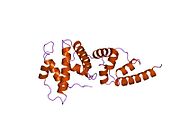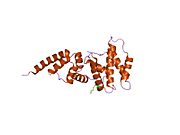CYTH2
An Error has occurred retrieving Wikidata item for infobox Cytohesin-2 is a protein that in humans is encoded by the CYTH2 gene.[1][2][3]
Function
Cytohesin-2 (CYTH2), formerly known as Pleckstrin homology, Sec7 and coiled/coil domains 2 (PSCD2), is a member of the cytohesin family. Members of this family have identical structural organization that consists of an N-terminal coiled-coil motif, a central Sec7 domain, and a C-terminal pleckstrin homology (PH) domain. The coiled-coil motif is involved in homodimerization, the Sec7 domain contains guanine-nucleotide exchange protein (GEP) activity, and the PH domain interacts with phospholipids and is responsible for association of CYTHs with membranes. Members of this family appear to mediate the regulation of protein sorting and membrane trafficking. CYTH2 exhibits GEP activity in vitro with ARF1, ARF3, and ARF6. CYTH2 protein is 83% homologous to CYTH1. Two transcript variants encoding different isoforms have been found for this gene.[3]
Interactions
CYTH2 has been shown to interact with Arrestin beta 2[4] and Arrestin beta 1. [4]
References
- ^ Kolanus W, Nagel W, Schiller B, Zeitlmann L, Godar S, Stockinger H, Seed B (Sep 1996). "Alpha L beta 2 integrin/LFA-1 binding to ICAM-1 induced by cytohesin-1, a cytoplasmic regulatory molecule". Cell. 86 (2): 233–42. doi:10.1016/S0092-8674(00)80095-1. PMID 8706128. S2CID 18390795.
- ^ Chardin P, Paris S, Antonny B, Robineau S, Béraud-Dufour S, Jackson CL, Chabre M (1996). "A human exchange factor for ARF contains Sec7- and pleckstrin-homology domains". Nature. 384 (6608): 481–4. Bibcode:1996Natur.384..481C. doi:10.1038/384481a0. PMID 8945478. S2CID 4361989.
- ^ a b "Entrez Gene: PSCD2 pleckstrin homology, Sec7 and coiled-coil domains 2 (cytohesin-2)".
- ^ a b Claing A, Chen W, Miller WE, Vitale N, Moss J, Premont RT, Lefkowitz RJ (Nov 2001). "beta-Arrestin-mediated ADP-ribosylation factor 6 activation and beta 2-adrenergic receptor endocytosis". J. Biol. Chem. 276 (45): 42509–13. doi:10.1074/jbc.M108399200. PMID 11533043.
Further reading
- Meacci E, Tsai SC, Adamik R, Moss J, Vaughan M (1997). "Cytohesin-1, a cytosolic guanine nucleotide-exchange protein for ADP-ribosylation factor". Proc. Natl. Acad. Sci. U.S.A. 94 (5): 1745–8. Bibcode:1997PNAS...94.1745M. doi:10.1073/pnas.94.5.1745. PMC 19987. PMID 9050849.
- Frank S, Upender S, Hansen SH, Casanova JE (1998). "ARNO is a guanine nucleotide exchange factor for ADP-ribosylation factor 6". J. Biol. Chem. 273 (1): 23–7. doi:10.1074/jbc.273.1.23. PMID 9417041.
- Mossessova E, Gulbis JM, Goldberg J (1998). "Structure of the guanine nucleotide exchange factor Sec7 domain of human arno and analysis of the interaction with ARF GTPase". Cell. 92 (3): 415–23. doi:10.1016/S0092-8674(00)80933-2. PMID 9476900. S2CID 8093935.
- Cherfils J, Ménétrey J, Mathieu M, Le Bras G, Robineau S, Béraud-Dufour S, Antonny B, Chardin P (1998). "Structure of the Sec7 domain of the Arf exchange factor ARNO". Nature. 392 (6671): 101–5. Bibcode:1998Natur.392..101C. doi:10.1038/32210. PMID 9510256. S2CID 4334627.
- Venkateswarlu K, Oatey PB, Tavaré JM, Cullen PJ (1998). "Insulin-dependent translocation of ARNO to the plasma membrane of adipocytes requires phosphatidylinositol 3-kinase". Curr. Biol. 8 (8): 463–6. doi:10.1016/S0960-9822(98)70181-2. PMID 9550703. S2CID 12974067.
- Kim HS (1998). "Assignment of the human cts18.1 gene PSCD2L to chromosome 19 band q13 using a radiation hybrid mapping panel". Cytogenet. Cell Genet. 83 (1–2): 43. doi:10.1159/000015163. PMID 9925920. S2CID 31220052.
- Santy LC, Frank SR, Hatfield JC, Casanova JE (1999). "Regulation of ARNO nucleotide exchange by a PH domain electrostatic switch". Curr. Biol. 9 (20): 1173–6. doi:10.1016/S0960-9822(00)80019-6. PMID 10531036. S2CID 17664498.
- Ogasawara M, Kim SC, Adamik R, Togawa A, Ferrans VJ, Takeda K, Kirby M, Moss J, Vaughan M (2000). "Similarities in function and gene structure of cytohesin-4 and cytohesin-1, guanine nucleotide-exchange proteins for ADP-ribosylation factors". J. Biol. Chem. 275 (5): 3221–30. doi:10.1074/jbc.275.5.3221. PMID 10652308.
- Smith JS, Tachibana I, Pohl U, Lee HK, Thanarajasingam U, Portier BP, Ueki K, Ramaswamy S, Billings SJ, Mohrenweiser HW, Louis DN, Jenkins RB (2000). "A transcript map of the chromosome 19q-arm glioma tumor suppressor region". Genomics. 64 (1): 44–50. doi:10.1006/geno.1999.6101. PMID 10708517.
- Vitale N, Pacheco-Rodriguez G, Ferrans VJ, Riemenschneider W, Moss J, Vaughan M (2000). "Specific functional interaction of human cytohesin-1 and ADP-ribosylation factor domain protein (ARD1)". J. Biol. Chem. 275 (28): 21331–9. doi:10.1074/jbc.M909642199. PMID 10748148.
- Macia E, Paris S, Chabre M (2000). "Binding of the PH and polybasic C-terminal domains of ARNO to phosphoinositides and to acidic lipids". Biochemistry. 39 (19): 5893–901. doi:10.1021/bi992795w. PMID 10801341.
- Lee SY, Pohajdak B (2000). "N-terminal targeting of guanine nucleotide exchange factors (GEF) for ADP ribosylation factors (ARF) to the Golgi". J. Cell Sci. 113 (11): 1883–9. doi:10.1242/jcs.113.11.1883. PMID 10806099.
- Claing A, Chen W, Miller WE, Vitale N, Moss J, Premont RT, Lefkowitz RJ (2001). "beta-Arrestin-mediated ADP-ribosylation factor 6 activation and beta 2-adrenergic receptor endocytosis". J. Biol. Chem. 276 (45): 42509–13. doi:10.1074/jbc.M108399200. PMID 11533043.
- Kitano J, Kimura K, Yamazaki Y, Soda T, Shigemoto R, Nakajima Y, Nakanishi S (2002). "Tamalin, a PDZ domain-containing protein, links a protein complex formation of group 1 metabotropic glutamate receptors and the guanine nucleotide exchange factor cytohesins". J. Neurosci. 22 (4): 1280–9. doi:10.1523/JNEUROSCI.22-04-01280.2002. PMC 6757580. PMID 11850456.
- Mansour M, Lee SY, Pohajdak B (2002). "The N-terminal coiled coil domain of the cytohesin/ARNO family of guanine nucleotide exchange factors interacts with the scaffolding protein CASP". J. Biol. Chem. 277 (35): 32302–9. doi:10.1074/jbc.M202898200. PMID 12052827.
- Buchet-Poyau K, Mehenni H, Radhakrishna U, Antonarakis SE (2002). "Search for the second Peutz-Jeghers syndrome locus: exclusion of the STK13, PRKCG, KLK10, and PSCD2 genes on chromosome 19 and the STK11IP gene on chromosome 2". Cytogenet. Genome Res. 97 (3–4): 171–8. doi:10.1159/000066620. PMID 12438709. S2CID 36446950.
- Huh M, Han JH, Lim CS, Lee SH, Kim S, Kim E, Kaang BK (2003). "Regulation of neuritogenesis and synaptic transmission by msec7-1, a guanine nucleotide exchange factor, in cultured Aplysia neurons". J. Neurochem. 85 (1): 282–5. doi:10.1046/j.1471-4159.2003.01718.x. PMID 12641750. S2CID 35888745.



![1r8s: ARF1[DELTA1-17]-GDP IN COMPLEX WITH A SEC7 DOMAIN CARRYING THE MUTATION OF THE CATALYTIC GLUTAMATE TO LYSINE](https://upload.wikimedia.org/wikipedia/commons/thumb/6/68/PDB_1r8s_EBI.jpg/180px-PDB_1r8s_EBI.jpg)
![1s9d: ARF1[DELTA 1-17]-GDP-MG IN COMPLEX WITH BREFELDIN A AND A SEC7 DOMAIN](https://upload.wikimedia.org/wikipedia/commons/thumb/8/84/PDB_1s9d_EBI.jpg/180px-PDB_1s9d_EBI.jpg)

